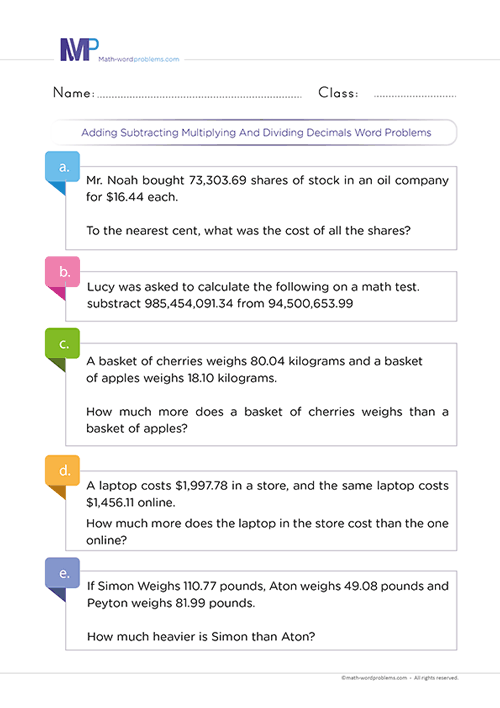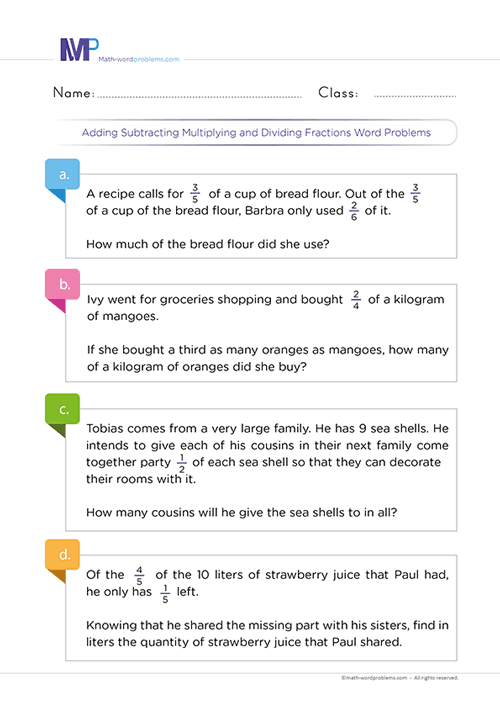 How to solve addition, subtraction, multiplication, and division of decimals word problems
How to solve addition, subtraction, multiplication, and division of decimals word problems
Encourage your 5th graders to practice how to solve addition, subtraction, multiplication, and division of decimals word problems using straightforward steps and solving procedures.
This procedure involves finding the most important numbers in the problem, determining the operation to use, then applying this operation to solve the problem regardless of the nature or how complex the problem is.
With this organized way of tackling word problems, your kids will get an ample conceptual understanding of them and improve their performance in solving them.
Steps to solve addition, subtraction, multiplication, and division of decimals word problems
We’ve got uncomplicated steps to solve addition, subtraction, multiplication, and division of decimal word problems here for your 5th graders. These steps will motivate kids and embed excellent skills to solve real-life situations requiring addition, subtraction, multiplication, or division of decimals. And the most complex grade 5 word problems with no difficulties at all.
In addition, the amazing examples we’ve added below will help your kids learn how to use these skills excellently and reinforce their skills as well.
Step 1: IDENTIFY THE PROBLEM
To identify the problem, you need to find what the problem wants you to tackle. I.e., are you going to add, subtract, multiply, or divide? Also, you have to figure out the important numbers and keywords in the word problem.
- Firstly, if it is adding decimal numbers word problems, then you will see at least one of the keywords below: - add, plus, more, total, increase, together, Altogether, combined, sum, grow, join, both, in all, and, how many in all, how much, spend in all, etc.
- Secondly, suppose it is subtracting decimal numbers word problems. In that case, you will encounter the following keywords in the word problem: - less, minus, take away, left, decrease, difference, fewer, deduct, remain, change, how many more, left over, less than, how much longer/shorter, how much more, fewer than, discount, etc.
- Thirdly, suppose it is multiplying decimal numbers word problems. In that case, you will see at least one of the vital keywords below in the word problem: - times, multiplied by, product, product of, factor, of, multiply, times, multiple, double, triple, groups, by, twice, area, equal groups, every, in all, total, increased by, as much, each, lots of, groups of, per, etc.
- Finally, suppose it is dividing decimal numbers word problems. In that case, you will see at least one of the keywords below in the word problem: - divide, half, evenly, every, per, parts, out of, quotient of, ratio of, how many in each, equal parts, cut up, average, as much, etc.
Note: One key Element for learners to understand is that they should not always rely on keywords alone. That is to say; the same keyword can have different meanings in different word problems.
- For this reason, we reiterate on the importance of reading the question very carefully to understand the situation that the word problem is describing, then figure out exactly which operation to use
Step 2: STRATEGIZE OR GATHER RELEVANT INFORMATION
How will you solve or tackle the problem?
One key thing you should remember is that each word problem may require a different format. So, these key points below will help kids to solve any format however it comes accurately.
- From the keyword(s) in the word problem, you will determine if you need to perform an addition, a subtraction, a multiplication, or a division operation.
- However, it would be best not to only rely totally on keywords. Instead, try to understand the situation that the problem is describing.
- Next, after knowing which operation you will perform, construct short sentences to represent the given word problem.
Step 3: CREATE THE EQUATION
Here, you have to write down a numerical equation representing the information in the word problem.
Step 4: PROVIDE A SOLUTION
From Step 3 above, add, subtract, multiply or divide the decimal numbers. Furthermore, include the unit of measurement in your final result.
Step 5: CHECK YOUR WORK
Last but not the least, ask yourself this question. “Does my answer make sense?” If “YES,” you are done. If “NO,” go back to step 1 and start all over again.
Examples on how to add, subtract, multiply and divide decimals word problems.
Example one: How to subtract decimals word problems.
Step 1: The important numbers here are 90.2kg and 25,960g. The keyword found in the word problem is “how much more.”
Step 2:Now, how will you solve the problem? The keyword(s) “how much more” found in the word problem requires you to use a subtraction operation.
However, if you read the question keenly, you’ll see that the question presents two different units. So what does that tell you? It tells you, you must work with one unit, either grams or kilograms.
Now, the question is, which unit will you work with? Since we are working with decimals word problems, it would be best to use the unit with a decimal nmber, i.e., kilograms.
Next, construct short sentences to represent the given word problem.
- Weight of the basket of cherries = 90.2kg
- Weight of the basket of apples = 25,960g
- Therefore, how much more the basket of cherries weighs than a basket of apples = Weight of the basket of cherries - Weight of the basket of apples.
Step 3:Write down a numerical expression to represent the bolded sentence in step 2 above to solve this word problem:
90.2kg – 25,960g = ?
Step 4: From step 3 above,
- normally, you cannot subtract grams from kilograms. Hence, you have to convert to one unit before you proceed. Also we discovered in step 1 that you have to work with kilograms.
So, you have to visit your metric unit of measurement of weight conversion table to convert 2,596 grams to kilograms.
If 1000g = 1kg,
Then 25,960g = (25,960 ÷ 1,000) kg = 25.96kg
Now, 90.2kg – 25,960g = 90.2kg – 25.96kg - Now arrange or stack the values so that the decimal points line up in the minuend, subtrahend, and difference. Also, use zeros as place value holders if necessary. Then, go ahead and subtract the values. Do not forget to include the unit of measurement in your final result.
So, the basket of cherries weighs 64.24 kilograms more than the basket of apples.
Step 5:Finally, check if your answer makes sense. For instance, estimate the answer and see if it is close to what you expected. However, if the answer is not what you expected, go back to step 1 and start all over again.
Example two: how to add decimals word problems.
Step 1: The important numbers here are 90.23kg and 25.96kg. The keyword found in the word problem is “total” and “combined.”
Step 2:Now, how will you solve the problem? The keyword(s) “total” and “combined found in the word problem call for you to use an addition operation.
Next, form short sentences to represent the given word problem.
- Weight of the basket of cherries = 90.23kg
- Weight of the basket of apples = 25.96kg
- Therefore, the weight of all the baskets = the weight of the basket of cherries + the weight of the basket of apples.
Step 3:Here, you have to write down a numerical equation to represent the sentence bolded in step 2 above to proceed with the solution to this problem:
90.23kg + 25.96kg = ?
Step 4: From step 3 above, stack the values so that the decimal points line up in the addends and sum. Also, use zeros as place values if necessary. Then, go ahead and add the values. Do not forget the sign, if any.
116.19kg to the nearest whole number is 116kg
So, the weight of the baskets combined is 116 kilograms.
Step 5:Finally, check if your answer makes sense. For instance, estimate the answer and see if it is close to what you expected. However, if the answer is not what you expected, go back to step 1 and start all over again.
Example three: Here is how to divide decimals word problems.
Step 1: The important numbers here are $50.26 and 5 (five friends). The keyword(s) found in the word problems are “each” and “equally.”
Step 2:Next, how will you solve the problem? From the situation that the word problem describes and the keyword(s) found in the word problem, you need to perform a division operation.
Now, construct short phrases to represent the given word problem.
- Total amount of the bill = $50.26
- Number of people that divided the bill = 5
- Therefore, the amount of money each person paid = the total bill ÷ number of people that divided the bill.
Step 3:Then, write down a numerical equation to represent the sentence bolded in step 2 above to proceed with the solution to this problem:
$50.26 ÷ 5 = ?
Step 4:From step 3 above, set up a long division sign, arrange the numbers, and then solve (follow the long division steps). Remember to include the unit of measurement to the final answer.
$10.052 to the nearest cent is $10.05
So, each person paid $10.05.
Step 5: Finally, check if your answer makes sense. For instance, estimate the answer and see if it is close to what you expected. However, if the answer is not what you expected, go back to step 1 and start all over again.
Example four: How do you multiply decimals word problems?
Step 1: The important numbers here are 12.5 and 24(number of hours in a day). The keyword(s) found in the word problem is “per.”
Step 2: Now, how will you solve the problem? The keyword(s) found in the word problem calls for you to perform a multiplication operation.
Next, form short sentences to represent the given word problem.
- Distance he walked per hour = 12.5km
- Number of hours in a day = 24 hours
- Therefore, the number of kilometers he can walk in a day = the distance he walks per hour × the number of hours in a day.
Step 3:Now, write down a numerical expression to represent the bolded sentence in step 2 above to proceed with the solution to this problem:
12.5 × 24 = ?
Step 4: From step 3 above, multiply the numbers using regrouping or other multiplication methods like long multiplication, grid multiplication, and lattice to determine the result.
Also, since it is multiplication of decimals, we need to multiply the values as if they were whole numbers while ignoring the decimal points.
Then, count the number of digits after the decimal in each given factor.
Now, put the same number of digits behind the decimal in the product.
In addition to this, do not forget to attach the unit of measurement to your final result.
So, he can walk 300.0 kilometers in a day.
Step 5: Finally, check if your answer makes sense. For instance, estimate the answer and see if it is close to what you expected. However, if the answer is not what you expected, go back to step 1 and start all over again.






